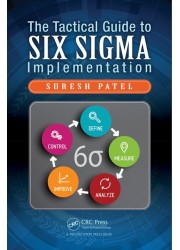The Tactical Guide to Six Sigma Implementation
Quantity:
-
Add to Compare
Simplifying a complex subject and removing the intimidation of using statistics, the book takes readers through the five phases of the Six Sigma methodology—Define-Measure-Analyze-Improve-Control (DMAIC). In ten clearly written and easy-to-understand chapters, readers learn the purpose of each phase and what activities must be performed in each phase.
The book illustrates the layout of the interaction of organizational processes—defining product and information flows separately such that each process receives product or information and, after completion of the process, supplies the output to the next process.
The author identifies organizational processes through turtle and SIPOC diagrams, defining the process owner, inputs and outputs, and process customer for each process. He also explains how to determine the measures and goals of the process, and how to document the process so that further process improvements can be implemented through management reviews.
The text presents a comprehensive process control plan assessment to comply with automotive, aerospace, and all types of manufacturing and service processes. It details 17 global quality management system processes covering management responsibility, resource management, product realization policies, and management analysis and improvement policies. It also provides comprehensive root cause analysis and problem solving techniques.
Numerous figures, charts, formulae and forms are included throughout the book and all statistics are described to the exact level of understanding required. Books in this series are suitable for use as basic textbooks for Green Belt, Black Belt, BBA, and MBA courses in global quality, Lean Six Sigma, and business excellence
Table of Contents
Introduction to Six Sigma: A Tactical Strategy
Origin of Six Sigma at Motorola
Understanding the Variation, Spread, and Sigma
DMAIC Process
What Is Six Sigma?
Basic Statistics
Definition of Sample Statistic, Population, and Population Parameter
Central Limit Theorem and Standard Normal Distribution
Central Tendencies
Measure of Dispersion
Business Performance Measures
Organizational Processes and Their Impact on the Organization
Defining Owners and Stakeholders
Balanced Scorecard
Key Performance Indicators
Important Measures of Quality Performance
Team Management
Define
Key Concepts and Tools
Voice of the Customer
Project Charter
Project Tracking
Define Phase Summary
Measure
Process Characteristics
Measurement System Analysis
Process Capability Measurement
Measure Phase Summary
Analyze
Regression and Correlation
Analysis of Variance
Hypothesis Testing
Gap Analysis
Root Cause Analysis
Improve
Prioritization through Cause-and-Effect Matrix
Theory of Constraints
Control
Statistical Process Control
Control Chart Guide
Control Plan
Sustenance of Improvements
Design for Six Sigma
DFSS and Six Sigma
DFSS and ROI
DFSS Methodologies
Case Study: Improvement Using Lean Six Sigma
Recognize and Identify Key Business: Game of Cricket
Case Study Learning Objectives
Define Phase: Identify Evidence of Singh’s Cricketing Problem
Measure Phase
Analyze Phase
Improve Phase
Control Phase
Standardize
Integrate
Glossary
Bibliography
Index
Write a review
Your Name:Your Review: Note: HTML is not translated!
Rating: Bad Good
Enter the code in the box below:
Copyright © 2014 Engineering Standards Bureau. All Rights Reserved.
Developed By Zoom Into Web







